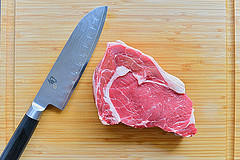Lean meats are a healthy part of any nutritious diet, but it’s very important to handle them properly to avoid illness. Be sure to follow these important tips for buying and preparing raw meat.
- Purchase only high-quality meats. When shopping for steak, chicken, fish, or other meats, always look for the Safe Food Handling label on the package. Also, use your own discretion to examine meat before purchasing, and be sure that it’s wrapped tightly and packaged in a bag away from other foods.
- Store meat safely. Meat must remain at a cold temperature until you’re ready to prepare it, so store it in your refrigerator and put it in the refrigerator’s meat bin if possible. Fresh meats should be used within three to four days, while meats like sausage and ground beef should be used within two days.
- Keep yourself (and your counters) safe. Always wash your hands thoroughly before and after handling raw meat. It’s also important to only use cutting boards and utensils for meat to avoid cross-contamination.
- Cook meat completely. Be sure to defrost meat in the refrigerator or the microwave; never let raw meat sit on the countertop to defrost. Once it’s time to cook your meat, use a food thermometer to see that ground meats reach at least 160°F and that beef and pork reach 145°F.
Food Safety: How to Handle Raw Meat [Beef Retail]
Keeping Your Meat Safe [Home Food Safety]
Meat [FoodSafety.gov]
Safe Food Handling: What You Need to Know [FDA]





 Equal Housing Opportunity
Equal Housing Opportunity